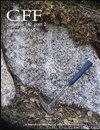瑞典北部LiikavaaraÖstra Cu-(W-Au)矿床的矿物学和特征
IF 1.2
4区 地球科学
Q2 GEOLOGY
引用次数: 4
摘要
摘要LiikavaaraÖstra铜(W-Au)矿床位于瑞典北部Aitik铜金矿附近。它计划在2023年生产。矿床缺乏现代地质描述,尽管在作业前了解地质和矿物学细节有助于避免意外。在本研究中,对下盘花岗闪长质侵入体的围岩、主岩和矿化进行了岩石学、矿物学和地球化学调查,并进行了锆石U-Pb分析。矿化主要由石英±电气石-方解石脉、方解石脉和细晶岩脉组成,细晶岩岩脉横切黑云母-角闪石片岩和片麻岩。矿石的围岩为玄武岩至安山岩成分的变质火山碎屑岩。花岗闪长岩侵入出现在下盘。矿化主要为黄铜矿、磁黄铁矿和黄铁矿,以及一些闪锌矿、方铅矿、白钨矿、辉钼矿和磁铁矿。Au、Ag和Bi略有富集。金和Ag以驻极体和Ag的形式存在,也存在于橙皮矿和硫化银中。铋矿物学包括原生铋、碲化铋和硫化铋。这些矿物以包裹体的形式存在于黄铜矿、黄铁矿、磁黄铁矿、闪锌矿、辉钼矿和石英的边界和裂缝中。下盘花岗闪长岩侵入体的年代为1.87 Ga。根据其与矿化的空间关系,以及矿石的高盐度流体和金属成分,这里认为它是矿石成因的来源。细晶岩脉可能是将金属从侵入体输送到主岩的岩浆热液的通道。本文章由计算机程序翻译,如有差异,请以英文原文为准。
Mineralogy and character of the Liikavaara Östra Cu-(W-Au) deposit, northern Sweden
ABSTRACT The Liikavaara Östra Cu-(W-Au) deposit is situated close to the operating Aitik Cu-Au mine in northern Sweden. It is scheduled for production in 2023. Modern geological descriptions of the deposit are lacking though knowledge of geological and mineralogical details prior to operation is beneficial to avoid surprises. In this study, petrological, mineralogical and geochemical investigations of the wall rocks, host rock and mineralisation, and zircon U-Pb analysis of a footwall granodioritic intrusion were carried out. The mineralisation is hosted by quartz±tourmaline-calcite veins, calcite veins and aplite dykes that cross-cut biotite-amphibole schists and gneisses. The wall rocks to the ore are metavolcaniclastic rocks of basaltic to andesitic composition. A granodiorite intrusion occurs in the footwall. The mineralisation is mainly chalcopyrite, pyrrhotite and pyrite with some sphalerite, galena, scheelite, molybdenite and magnetite. It shows slight enrichments in Au, Ag and Bi. Gold and Ag occur as electrum and Ag also in hessite and an Ag-sulphide. The Bi mineralogy includes native Bi, Bi-tellurides and Bi-sulphides. These minerals are found as inclusions, along the borders of and in cracks in chalcopyrite, pyrite, pyrrhotite, sphalerite, molybdenite and quartz. The footwall granodiorite intrusion was dated at 1.87 Ga. It is suggested here to be the source for ore genesis based on its spatial relation to the mineralisation, as well as on high-salinity fluids and metal composition of the ore. The aplite dykes may have acted as pathways for the magmatic hydrothermal fluids that carried the metals from the intrusion to the host rock.
求助全文
通过发布文献求助,成功后即可免费获取论文全文。
去求助
来源期刊

Gff
地学-地质学
CiteScore
2.80
自引率
10.00%
发文量
11
审稿时长
>12 weeks
期刊介绍:
GFF is the journal of the Geological Society of Sweden. It is an international scientific journal that publishes papers in English covering the whole field of geology and palaeontology, i.e. petrology, mineralogy, stratigraphy, systematic palaeontology, palaeogeography, historical geology and Quaternary geology. Systematic descriptions of fossils, minerals and rocks are an important part of GFF''s publishing record. Papers on regional or local geology should deal with Balto-Scandian or Northern European geology, or with geologically related areas. Papers on geophysics, geochemistry, biogeochemistry, climatology and hydrology should have a geological context. Descriptions of new methods (analytical, instrumental or numerical), should be relevant to the broad scope of the journal. Review articles are welcome, and may be solicited occasionally. Thematic issues are also possible.
 求助内容:
求助内容: 应助结果提醒方式:
应助结果提醒方式:


